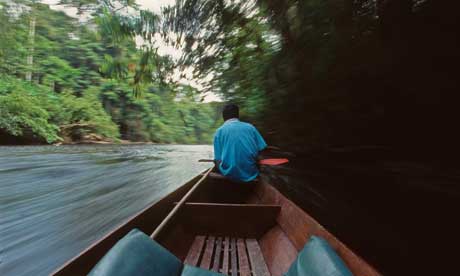
Entering the rainforest needs preparation: the equipment, clothes and medicine. A great shot inside takes good planning too
Tropical forests are wonderful places, both to photograph and just to experience, but they can eat you and your equipment. Moisture and humidity levels can be phenomenal, temperatures high, and insects and other creatures – often including those lovable leeches – abundant.
So you need to protect your equipment. If you are not actually using your gear, keep it sealed in zip-lock plastic bags, protected by a desiccant such as silica gel. Replenish your gel every night by heating it up near a camping stove or fire.
When you are actually shooting, you can protect your kit by using a shower cap or even clingfilm. To protect the front of your lens from moisture, always use a UV filter, and carry a roll of soft toilet paper to wipe it. This should be sealed in a bag, with a bit pointing out through a small slit, to keep it dry.
Getting the right exposure can also be tough. Light levels under the canopy are generally very low; in order to avoid camera shake and have adequate depth of field, always try to use a tripod. You could just increase the ISO and use a wide aperture, but you won’t get the biting quality that a small aperture and a tripod will give you.
If you shoot on auto, dark green vegetation and the many shadows from leaves will fool your meter into overexposing. This sort of subject will often need at least a whole stop less exposure to correctly render. If in doubt, bracket (with film) or check the histogram reading (on a digital camera) to ensure you have worked out the exposure correctly. Almost all digital cameras can show a histogram, a useful chart showing the range of tones in the image.
The contrast between bright sunlight (in clearings or overhead) and deep shadow (in the foliage) may look stunning to the eye, but the latitude will be far too great for your camera to correctly expose both in the same shot. You should try to recompose with just one lighting condition dominating most of the photograph.
If you have an area of shadow in the foreground, you can try to balance it by using fill-in flash. This is where you work out the exposure for the bright areas, and then fire the flash to light the bits in shadow. This will only work if the shadow area is close to you, as most camera flashes aren’t very powerful.
The light in the jungle will be quite cold and blue. To restore the true colours as you see them, use a warm-up filter such as an 81C (if you are shooting film), or select the ‘shade’ setting on your digital camera’s white balance facility.
It’s remarkably difficult to frame a good jungle photograph, and it is easy to take pictures that have no point of interest. To avoid this, either go wide or go close.
For the wide perspective, try to find an overview or a lookout point which will let you shoot the vast stretch of the jungle. Overviews like this are quite difficult to find and, unless you have the ability to scale trees, you will probably have to rely on a maintained viewpoint for tourists; even if you find a hill, the view may well be obscured by vegetation. For maximum drama, get there early to catch the dawn mist. Alternatively, aerial walkways get you up into the canopy for pictures of parts of the jungle that are often hidden. Keep a lookout for rivers or waterfalls, where sun breaks through the canopy of trees, enabling you to play with lighting effects.
Close-ups are far easier to arrange. Once you stop seeing the jungle as a single entity you’ll begin to appreciate the shapes, textures and forms of the various plants. Try not to shoot a single thing in isolation, but build layers in your pictures. Shoot a close-up, but have a recognisable background to give a sense of place. This background can be rendered out of focus by using a shallow depth of field.
Although there is generally a lot of impressive wildlife in jungles, you’ll often be very lucky to see it, let alone photograph it. Smaller wildlife, such as butterflies, can be easier to spot and will give you more chance of taking a picture.
Finally, you can also make some great photos of your travels in and out of the jungle. Don’t just concentrate on nature, but on your own personal journey, whether it be by plane, boat or foot.